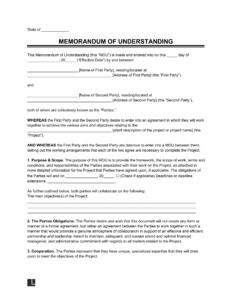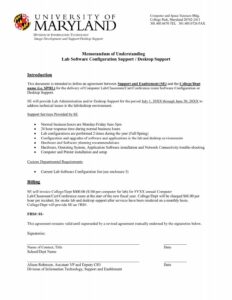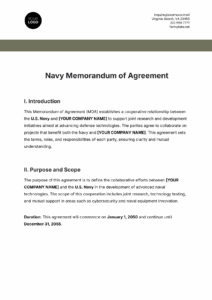Navigating the complexities of any organization, big or small, often involves a delicate dance of collaboration between different departments, teams, or even individual stakeholders. While external agreements with clients or partners might get all the formal attention, what happens inside your own walls is equally crucial for smooth operations and successful project execution. That’s where a clear understanding of internal arrangements becomes invaluable.
When projects span across various units or new initiatives require shared resources and responsibilities, misunderstandings can easily arise, leading to delays and inefficiencies. Having a structured way to document these internal agreements can prevent a lot of headaches, and that’s precisely what an internal memorandum of understanding template is designed to help you achieve, offering a professional and consistent approach to internal alignment.
What Exactly is an Internal Memorandum of Understanding and Why Do You Need One?
An Internal Memorandum of Understanding, often simply called an Internal MOU, is essentially a formal document that outlines an agreement between two or more internal parties within the same organization. Think of it as an internal handshake that’s been put down on paper, detailing the intentions, responsibilities, and expectations of each party involved in a specific project, initiative, or ongoing collaboration. It’s not usually a legally binding contract in the same way an external agreement might be, but it carries significant weight in establishing accountability and clarity within the company’s operational framework.
The primary purpose of an Internal MOU is to foster clarity and prevent ambiguity. In a bustling workplace, details can get lost in translation during verbal discussions or email exchanges. By formalizing these agreements, an Internal MOU ensures everyone is on the same page regarding project scope, timelines, resource allocation, and expected outcomes. It acts as a reference point that all parties can revert to should any questions or disputes arise down the line, saving valuable time and effort in trying to recall past conversations.
Beyond just preventing misunderstandings, Internal MOUs significantly contribute to improved efficiency and productivity. When roles and responsibilities are clearly delineated, there’s less overlap of effort, fewer gaps in execution, and a smoother workflow. It empowers teams to work more autonomously within their defined parameters, knowing exactly what is expected of them and what they can expect from others. This formalized approach can transform informal agreements into actionable plans, driving projects forward with greater purpose and less friction.
Consider a scenario where the marketing department needs creative assets from the design team for a new campaign, and the IT department needs to integrate a new software solution from the development team. Without a clear internal agreement, communication can break down, deadlines might be missed, and project success could be jeopardized. An Internal MOU provides that essential framework, making it particularly useful for cross-departmental projects, the launch of new initiatives, changes in departmental responsibilities, or even the establishment of new internal policies requiring shared oversight.
Key Components to Look For in Your Template
- Clearly identified parties involved (departments, teams, individuals)
- The specific purpose or objective of the agreement
- A detailed scope of work or project description
- Defined roles and responsibilities for each participating party
- Agreed-upon timelines, milestones, and deadlines
- Resource allocation, including budget, personnel, and equipment
- Communication protocols and reporting structures
- A dispute resolution mechanism, should one be needed
- Review and amendment procedures for the agreement
- Signatures of authorized representatives from all involved parties
How an Internal Memorandum of Understanding Template Streamlines Your Workflow
Implementing a well-designed internal memorandum of understanding template within your organization can dramatically simplify the process of documenting internal agreements. Instead of starting from a blank page every time a new collaboration or project arises, a template provides a pre-structured framework that guides you through all the necessary considerations. This means less time spent on drafting and formatting documents, and more time focused on the actual content of the agreement, ensuring that key details are never overlooked.
Consistency is another huge benefit. Using a standard template across all internal agreements ensures that every Internal MOU created within your company maintains a uniform look and includes all the essential sections. This not only presents a more professional image but also makes it easier for everyone involved to understand and navigate different agreements, as they will always find information in the same predictable locations. Such standardization contributes to greater organizational clarity and reduces the learning curve for new or less frequent users.
Furthermore, a good internal memorandum of understanding template is inherently adaptable. While it provides a solid foundation, it should also be flexible enough to be customized for various specific scenarios. Whether it’s a detailed project agreement, a shared resource allocation plan, or a simple clarification of roles, the template allows you to easily plug in the relevant information, modify specific clauses, and tailor the document to meet the unique demands of each internal arrangement without reinventing the wheel. This blend of structure and flexibility makes it an incredibly powerful tool for internal governance.
- Select the appropriate template that best fits the nature of your internal agreement.
- Fill in the specific details: names of departments/teams, project title, objectives, and specific dates.
- Clearly define the roles, responsibilities, and deliverables for each party involved.
- Outline any specific resources, budget, or support required and who will provide them.
- Establish timelines, milestones, and a clear process for monitoring progress and making decisions.
- Circulate the draft among all involved parties for review, feedback, and necessary revisions.
- Once all parties are in agreement, obtain the necessary signatures from authorized individuals.
- Distribute the signed Internal MOU to all stakeholders for their records and ongoing reference.
Establishing clear communication and documented agreements is a cornerstone of operational excellence within any company. It fosters an environment of transparency, mutual respect, and shared understanding, which are critical ingredients for successful collaborative efforts. By removing ambiguity and setting clear expectations upfront, teams can dedicate their energy to achieving their goals rather than untangling crossed wires.
Having a dependable framework to formalize these internal interactions empowers your teams to operate more cohesively and efficiently. It builds a culture where commitments are taken seriously and responsibilities are clearly owned, paving the way for smoother project execution and stronger internal partnerships that drive the organization forward.


